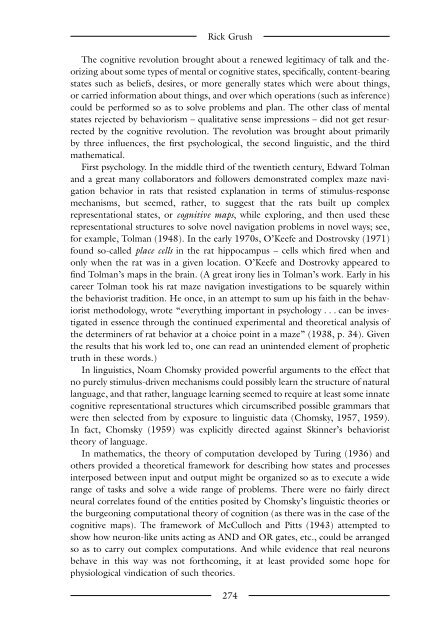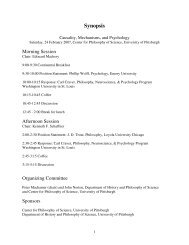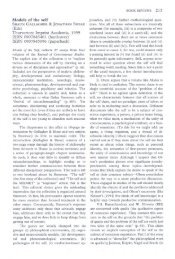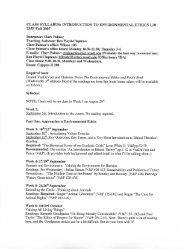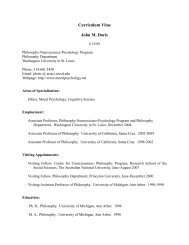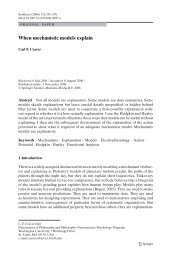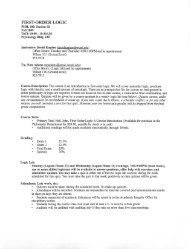The Blackwell Guide to the Philosophy of Science - The Department ...
The Blackwell Guide to the Philosophy of Science - The Department ...
The Blackwell Guide to the Philosophy of Science - The Department ...
You also want an ePaper? Increase the reach of your titles
YUMPU automatically turns print PDFs into web optimized ePapers that Google loves.
Rick Grush<br />
<strong>The</strong> cognitive revolution brought about a renewed legitimacy <strong>of</strong> talk and <strong>the</strong>orizing<br />
about some types <strong>of</strong> mental or cognitive states, specifically, content-bearing<br />
states such as beliefs, desires, or more generally states which were about things,<br />
or carried information about things, and over which operations (such as inference)<br />
could be performed so as <strong>to</strong> solve problems and plan. <strong>The</strong> o<strong>the</strong>r class <strong>of</strong> mental<br />
states rejected by behaviorism – qualitative sense impressions – did not get resurrected<br />
by <strong>the</strong> cognitive revolution. <strong>The</strong> revolution was brought about primarily<br />
by three influences, <strong>the</strong> first psychological, <strong>the</strong> second linguistic, and <strong>the</strong> third<br />
ma<strong>the</strong>matical.<br />
First psychology. In <strong>the</strong> middle third <strong>of</strong> <strong>the</strong> twentieth century, Edward Tolman<br />
and a great many collabora<strong>to</strong>rs and followers demonstrated complex maze navigation<br />
behavior in rats that resisted explanation in terms <strong>of</strong> stimulus-response<br />
mechanisms, but seemed, ra<strong>the</strong>r, <strong>to</strong> suggest that <strong>the</strong> rats built up complex<br />
representational states, or cognitive maps, while exploring, and <strong>the</strong>n used <strong>the</strong>se<br />
representational structures <strong>to</strong> solve novel navigation problems in novel ways; see,<br />
for example, Tolman (1948). In <strong>the</strong> early 1970s, O’Keefe and Dostrovsky (1971)<br />
found so-called place cells in <strong>the</strong> rat hippocampus – cells which fired when and<br />
only when <strong>the</strong> rat was in a given location. O’Keefe and Dostrovky appeared <strong>to</strong><br />
find Tolman’s maps in <strong>the</strong> brain. (A great irony lies in Tolman’s work. Early in his<br />
career Tolman <strong>to</strong>ok his rat maze navigation investigations <strong>to</strong> be squarely within<br />
<strong>the</strong> behaviorist tradition. He once, in an attempt <strong>to</strong> sum up his faith in <strong>the</strong> behaviorist<br />
methodology, wrote “everything important in psychology . . . can be investigated<br />
in essence through <strong>the</strong> continued experimental and <strong>the</strong>oretical analysis <strong>of</strong><br />
<strong>the</strong> determiners <strong>of</strong> rat behavior at a choice point in a maze” (1938, p. 34). Given<br />
<strong>the</strong> results that his work led <strong>to</strong>, one can read an unintended element <strong>of</strong> prophetic<br />
truth in <strong>the</strong>se words.)<br />
In linguistics, Noam Chomsky provided powerful arguments <strong>to</strong> <strong>the</strong> effect that<br />
no purely stimulus-driven mechanisms could possibly learn <strong>the</strong> structure <strong>of</strong> natural<br />
language, and that ra<strong>the</strong>r, language learning seemed <strong>to</strong> require at least some innate<br />
cognitive representational structures which circumscribed possible grammars that<br />
were <strong>the</strong>n selected from by exposure <strong>to</strong> linguistic data (Chomsky, 1957, 1959).<br />
In fact, Chomsky (1959) was explicitly directed against Skinner’s behaviorist<br />
<strong>the</strong>ory <strong>of</strong> language.<br />
In ma<strong>the</strong>matics, <strong>the</strong> <strong>the</strong>ory <strong>of</strong> computation developed by Turing (1936) and<br />
o<strong>the</strong>rs provided a <strong>the</strong>oretical framework for describing how states and processes<br />
interposed between input and output might be organized so as <strong>to</strong> execute a wide<br />
range <strong>of</strong> tasks and solve a wide range <strong>of</strong> problems. <strong>The</strong>re were no fairly direct<br />
neural correlates found <strong>of</strong> <strong>the</strong> entities posited by Chomsky’s linguistic <strong>the</strong>ories or<br />
<strong>the</strong> burgeoning computational <strong>the</strong>ory <strong>of</strong> cognition (as <strong>the</strong>re was in <strong>the</strong> case <strong>of</strong> <strong>the</strong><br />
cognitive maps). <strong>The</strong> framework <strong>of</strong> McCulloch and Pitts (1943) attempted <strong>to</strong><br />
show how neuron-like units acting as AND and OR gates, etc., could be arranged<br />
so as <strong>to</strong> carry out complex computations. And while evidence that real neurons<br />
behave in this way was not forthcoming, it at least provided some hope for<br />
physiological vindication <strong>of</strong> such <strong>the</strong>ories.<br />
274


